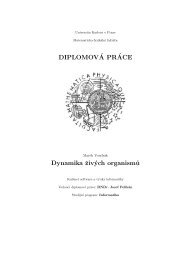MASTER THESIS Video Watermarking - Computer Graphics Group ...
MASTER THESIS Video Watermarking - Computer Graphics Group ...
MASTER THESIS Video Watermarking - Computer Graphics Group ...
You also want an ePaper? Increase the reach of your titles
YUMPU automatically turns print PDFs into web optimized ePapers that Google loves.
3.3 Decoding<br />
The decoding process is reversal process to encoding resulting in visual<br />
video data, as depicted in Figure 7.<br />
Incoming slices are decoded, using the same entropy coding as in the<br />
encoding process, up to intra prediction modes or motion vectors and quantized<br />
transform coefficients.<br />
Macroblock by macroblock, block by block, the quantized transform<br />
coefficients are scaled to the former range, i.e. multiplied by dequantization<br />
factors, and transformed by inverse frequency transform. Hereby, the prediction<br />
residual is obtained.<br />
<br />
<br />
<br />
<br />
<br />
Figure 7: Decoding process scheme<br />
The prediction process is invoked using the intra prediction mode in case of<br />
intra prediction, or the motion vector in case of inter prediction. Predicted<br />
samples are added to the residual.<br />
Such decoded blocks and macroblocks are joined together to form the visible<br />
picture that is stored in the buffer of reference pictures for the inter prediction<br />
process in next pictures.<br />
In both encoding and decoding processes, deblocking filter process is invoked<br />
over decoded pictures to increase final visual quality. The process eliminates<br />
blocking artefacts on block borders, as may be seen in video sequences<br />
compressed according to many of previous video coding standards at lower<br />
bit-rates.<br />
18
















